The genus Aloe (Aloe spp.) encompasses some 400 species of succulent plants, all of which are xerophyte examples, meaning they can survive with very little water. The aloe vera xerophyte is the best-known species in the genus. Most aloe species are native to Africa and the Middle East. The name Aloe is derived from the ancient Greek and Arabic names for the dried juice of aloe leaves.
The aloe vera plant has succulent, gray-green leaves that grow in an attractive rosette, with new leaves appearing at its center. Many different varieties of aloe vera exist, ranging in size, growth habit and color. Some of the bright-colored varieties are especially attractive as part of a succulent border or an indoor succulent collection. Aloe plants also vary in size and shape, with some varieties developing a central, tall stem and eventually taking on a tree-like form. Mature aloes often produce offshoots, small rosettes that appear at the base of the plant. The succulent leaves of aloes are usually green, although some types may feature pale green or white variegation or spots. Most types have few spines on the sword-shaped foliage.
Aloe vera has potential toxicity, with side effects occurring at some dose levels both when ingested and when applied topically. Although toxicity may be less when aloin is removed by processing, Aloe vera ingested in high amounts may induce side effects. Symptoms of aloe poisoning include diarrhea, abdominal pain, vomiting, loss of appetite, depression, tremors and a change in urine color.
- Aloe Ballyi
- Aloe Africans
- Aloe Aristata
- Aloe Polyphylla
- Aloe Striata
- Aloe Variegata
- Aloe Aculeata
- Aloe Broomii
- Aloe Chabaudii (Aloe ferox)
- Aloe Cryptopoda
- Aloe Grandidentata
- Aloe humilis
- Aloe Lineata
- Aloe Peglerae
- Aloe Saponaria
- Aloe vanbalenii
Aloe Ballyi (Rat aloe)
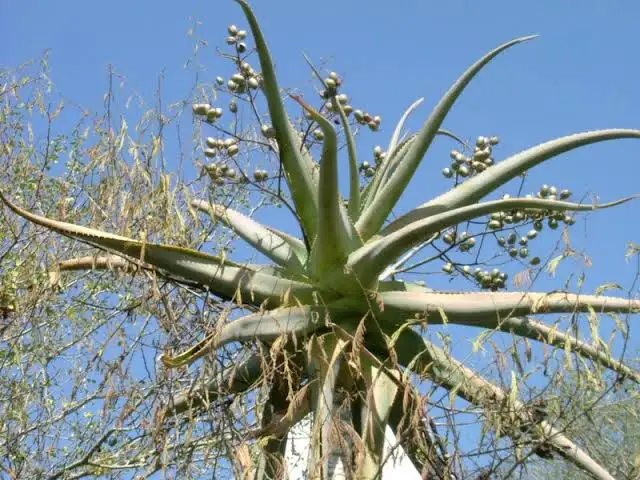
Also referred to as “rat aloe” is a type of aloe found only in Kenya and Tanzania. Its distinctive smell has been likened to that of a rat. This species forms tall, slender stems of up to 6 meters. The leaves are long, slender, and mostly straight – only recurving slightly towards the tips. Dead leaves do not long remain on the stem, unlike in the case of most aloes. Unlike most aloes, the “rat aloe” is poisonous. Inflorescences are multibranched, often re-branched, with bicolored flowers that are red in bud and turn yellow when they open.
Aloe Africans (Uitenhage aloe)
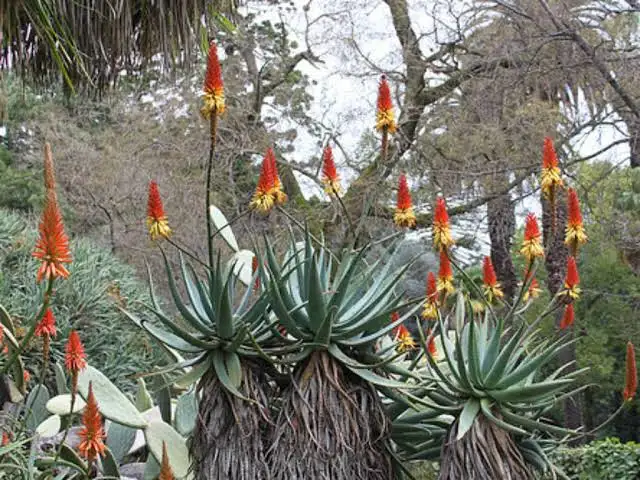
African aloe is a slow growing succulent plant, taking 4 to 5 years to produce its first blooms. Outdoors, it can grow to 12 or 13’ feet tall, but will usually be a smaller 6 to 8’ feet tall when kept in containers. It has a tree-like habit, which makes it compatible with a wide array of smaller succulents. The leaves of this plant are thin and narrow and gray-green, bearing a greener hue when shaded but gaining a purplish or pinkish hue when in drought conditions. They have a somewhat messy appearance with the 2’ foot long leaves spreading out and curving downwards towards the tips. Each leaf has small, sharp reddish teeth along the margins.
Aloe aristata (Lace Aloe)

The Lace Aloe, or Aloe aristata plant is a low-growing plant, which is mostly found in South Africa. It has fleshy, soft-spined dark green leaves, which have white bumps. As the weather changes, the leaves tend to change color and orange-red flowers grow on the long stems. Its branches are covered with peach-colored flowers in the summer, which helps attract bees.
Also Read: Different Types of Aloe Plants
Aloe polyphylla (Spiral Aloe)

Aloe polyphylla (Spiral Aloe) is a compact evergreen aloe with foliage arranged in a perfect spiral pattern. The fleshy gray-green leaves form a tight rosette that becomes a beautiful spiral, either clockwise or counterclockwise, as the plant ages. A plant can count up to 150 leaves geometrically arranged in 5 ranks. The leaves are adorned with white to pale-green spines along their edges and a dark, purplish brown terminal spine at their tips. This Aloe rarely flowers. When it does in spring and early summer, its red to salmon-pink tubular blooms are borne on a branching spike which emerges above the foliage.
Aloe striata (Coral Aloe)
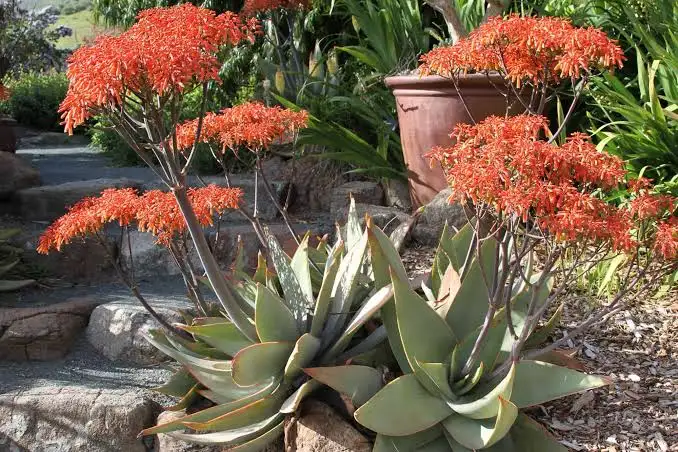
Aloe striata (Coral Aloe) is perennial type of aloe forming beautiful rosettes of flat broad leaves. Pale gray-green, the fleshy leaves warm up to pink in full sun or take on blue-gray hues in the shade. Toothless, the leaves exhibit subtle narrow stripes along their length and transparent pinkish red margins. In late winter into early spring, clusters of brilliant coral flowers are borne 2ft. (60 cm) above the foliage on tall candelabra stems, brightening up the dull winter garden. Up to three branched inflorescences can arise from a single rosette. Offsets will slowly appear around the base and form a small colony.
Aloe variegata (Tiger aloe)

Aloe variegata is instantly recognised by the sculptural shape of its elegant stiff foliage arranged in three separate ranks which slowly creates a tall spiral together with the distinctive white variegation on the leaves which forms an attractive irregular transverse banding. The marginal edges of each leaf has minute serrations. Aloe variegata, Tiger Aloe or Partridge Breast Aloe, is a distinctive Aloe from western South Africa and Southern Namibia and is one of the most popular Aloes in cultivation as it makes a stunning and rewarding house or container plant.
Aloe aculeata (Red hot poker aloe)

Aloe aculeata is an Aloe species that grows on rocky outcrops in grassland and dry bushveld and ‘Aculeata’ refers to the spines on the leaf’s surface and the teeth on its margins. This succulent, stemless aloe forms a single rosette of up to 1 m high and wide. The long, relatively broad leaves are up to 120 mm wide at their base. The upper parts are curved inwards, which gives the rosette a rounded appearance. The leaf margins are armed with reddish brown, triangular teeth. The upper and lower surfaces of the leaves are covered in distinctive thorns. Each thorn originates from a thick base, which in some forms is a lighter colour than the rest of the leaf, giving it a dotted appearance.
Also Read: Difference Between Aloe And Agave
Aloe broomii (Snake Aloe)

Aloe broomii (Snake Aloe) is a robust perennial forming a large, short-stemmed, dense rosette of light green leaves 30 cm. They are adorned with reddish brown teeth along the edges, which curl interestingly along the outer edges of each leaf. This Aloe develops a stunning, densely flowered, candle-like inflorescence, 4-5 ft. tall in which the buds and pale lemon flowers are covered by white long bracts. This makes this Aloe quite unique as the buds and open flowers are completely hidden by their large bracts and cannot be seen. Snake Aloe is usually solitary, but occasionally the heads divide to form groups of up to 3 rosettes.
Aloe ferox (bitter aloe)

Aloe ferox is a tall, single-stemmed aloe, that can grow to 10 feet in height. Its leaves are thick and fleshy, arranged in rosettes, and have reddish-brown spines on the margins with smaller spines on the upper and lower surfaces. The leaf surfaces of young plants are covered in spines; however, as they get taller and less vulnerable to grazing, the leaves begin to lose most of their spines except for those along the leaf margins. Plants in the western part of its natural range tend to keep more of their leaf surface spines. It’s flowers are a uniform orange or red, and stand between 2 and 4 feet above the leaves, in multi-branched inflorescences.
Aloe grandidentata (dwarf soap aloe)
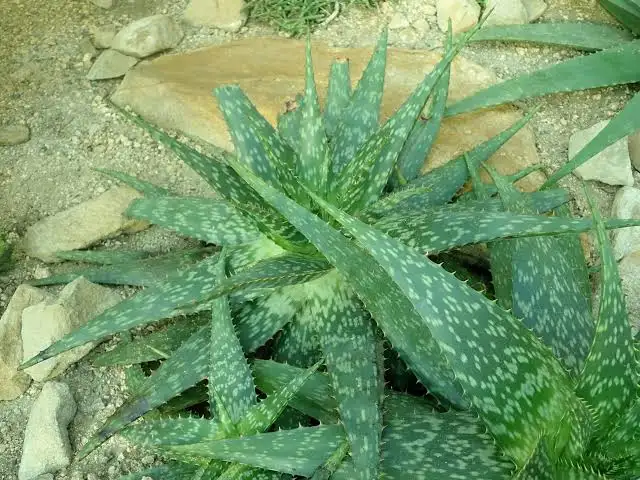
Aloe grandidentata is a small, low-growing, stemless, suckering species, with rosettes of toothed, dark green leaves that have attractive dull-white spots and markings on both surfaces.The flowers are tubular, wider at the apex than the base (clavate), 19–30 mm long, coral-pink to dull red, in dense, conical racemes, on branched, erect inflorescences, up to 900 mm tall, in early spring (August to September).
Aloe humilis
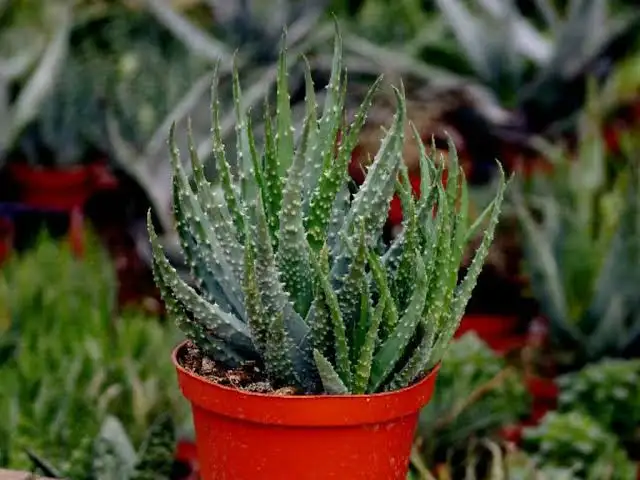
Aloe humilis, also known as spider aloe is a low growing type of aloe (succulent) that has dense clusters of small, stemless rosettes. The leaves are a pale blue-green or grey-green colour and typically triangular shaped, with a waxy coat covered in marginal spines and irregular spaced bumps. It can be found clinging to rock faces where it survives in the baking sun. In late winter into spring appear the unbranched 1 foot tall flower spikes bearing about 20 pendulous 1 1/2 inch long red-orange flowers.
Also Read: Different Types of Succulents
Aloe Peglerae (Fez aloe)

The fez aloe is typically 30–40 cm in diameter, and 30–40 cm in height. The glaucous leaves are strongly incurved to form a compact, spherical rosette. The inflorescence can be observed in July and August, and usually consists of a single cylindrical spike 30–40 cm tall, occasionally forked. The visible portions of filaments are deep purple in colour. It is listed as endangered and is rapidly declining in the wild, primarily due to habitat destruction and illegal collecting.
Aloe Saponaria (Aloe maculata)
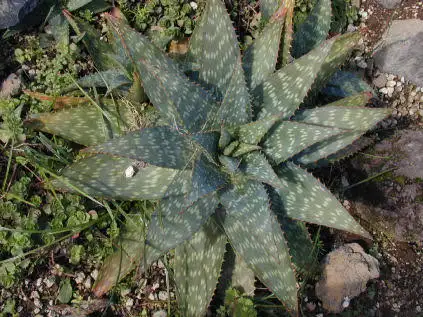
Aloe maculata, the soap aloe or zebra aloe is a very variable species and hybridizes easily with other similar aloes, sometimes making it difficult to identify. The leaves range in colour from red to green, but always have distinctive “H-shaped” spots. The flowers are similarly variable in colour, ranging from bright red to yellow, but are always bunched in a distinctively flat-topped raceme. The inflorescence is borne on the top of a tall, multi-branched stalk and the seeds are reputedly poisonous.
Aloe vanbalenii (Van Balen’s Aloe)
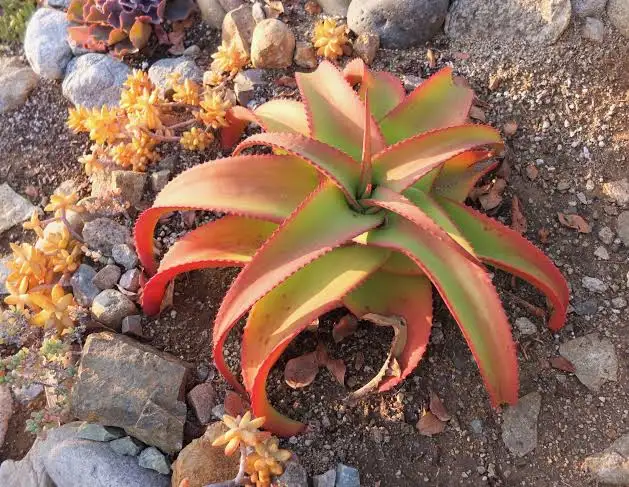
Resembling an octopus, Van Balen’s Aloe is a perennial forming striking stemless rosettes of long, deeply channelled, gracefully twisting and curling leaves. Bright green with copper-red edges in the shade, the fleshy leaves warm up to orange or dark red shades in full, hot sun with minimum water. Lined with reddish teeth, they emit a cinnamon or musky fragrance when bruised or damaged. In winter to early spring, slender, conical, yellow to orange-yellow, tubular flowers are produced on unbranched spikes, 3 ft. high (90 cm). They are attractive to nectar seeking birds and insects.